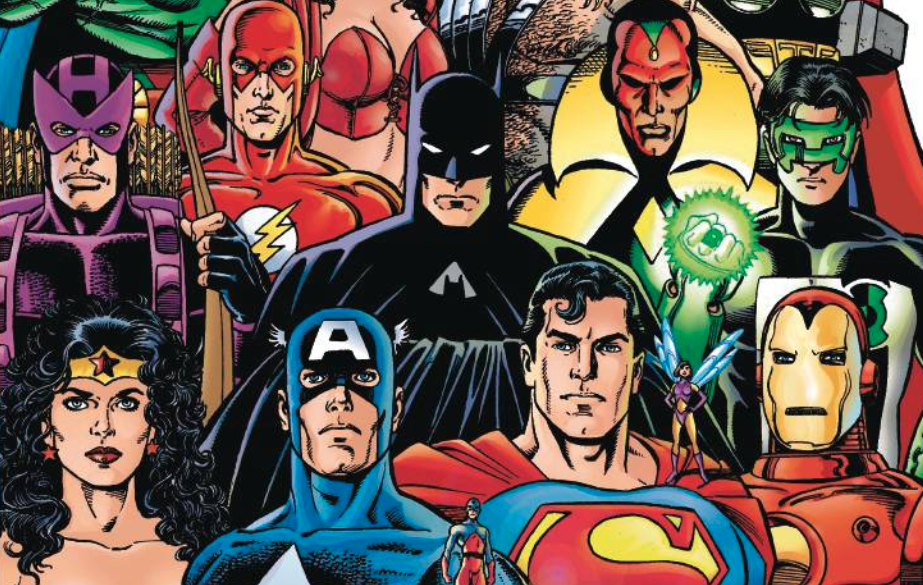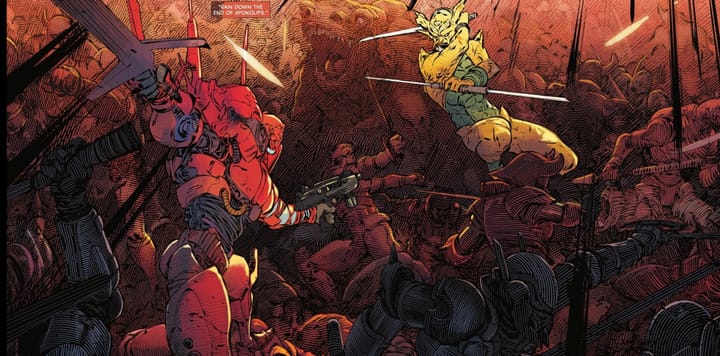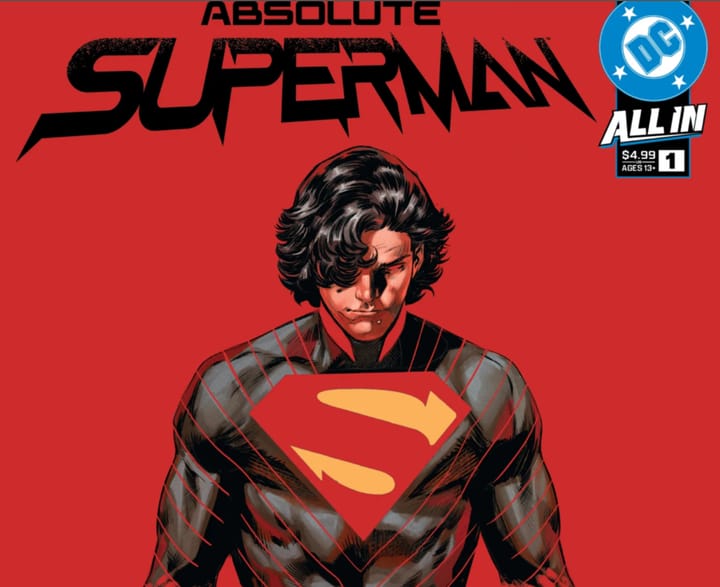What’s So Funny About Peace, Love, and George Perez’s JLA/Avengers?
An appreciation of George Pérez's stellar work on the JLA/Avengers crossover.

George Pérez, like Jack Kirby before him, refined the language of superhero comics. In the 1970s, Pérez was a blue-collar artist, working on a variety of comics and titles, from Justice League of America to Sons of the Dragon in Marvel’s Deadly Hands of Kung Fu magazine. The 1980s cemented his place in comics, first with a stellar character-driven run on The New Teen Titans. In that series, he reworked the concept of a team of teenage sidekicks and turned it into a story of growing up and out of the shadows of the previous generation. And then he turned in the universe-altering Crisis on Infinite Earths, creating the template for these kinds of massive crossovers events that have become all-too-common today. With both of those created along with writer Marv Wolfman, Pérez is often considered for the spectacle of his work rather than the strong storytelling of it. He’s the guy who puts every detail into every panel and fills his covers with hundreds of characters.
During the 1990s, Pérez seemed more like a journeyman rather than the superstar artist he actually was. He’d turn up for small events like Hulk: The Future Imperfect, would ink over Dan Jurgens on a Teen Titans revival, and do covers here or there but he never seemed to find anything series that he could devote himself to until Marvel teamed him up with Kurt Busiek to revive The Avengers in 1998. Together with Busiek, inker Al Vey, and colorist Tom McGraw, Pérez spent the next 3 years telling Avengers stories that stood up to the classic Stan Lee and Roy Thomas-penned comics of the 1960s. Busiek’s writing blends old school and modern sensibilities that were a great fit for The Avengers after many years that Marvel spent trying to make their books read and look like Image Comics. With Busiek, Pérez brought a sense of history to the run (some of his earliest work was in Avengers comics circa the mid-1970s) while his style had continued to develop into the sharp, detailed superhero mold. He took the works of Kirby, Adams, and Buscema as his foundational texts and continued to build on them to develop his distinct look.
Pérez left Marvel at the end of 2000 to go over and work exclusively at a new fledgling publisher Crossgen. Crossgen was looking to recreate the Bullpen work aspect that used to exist in comics, having all of their creators move to Florida (Pérez was already there) and work in a bullpen environment. But Pérez had one white whale project written into his contract to supersede his exclusivity with Crossgen. You see, back around 1983, Pérez started working on a Marvel/DC crossover, JLA & The Avengers. Back in those days, the two companies had worked on a handful of crossovers, Superman and Spider-Man, Batman and the Hulk, X-Men and the New Teen Titans. Pérez had started drawing this crossover (he was 21 pages into it) when both publishers killed the project. The whys and wherefores about the cancellation of the project are classic he said-she said back and forth between both companies.
Speculation and rumors followed the project’s demise for years. The rumors and hope were enough so that when George Pérez signed an exclusive contract with a non-Marvel/DC company, he had a clause written in that IF a JLA/Avengers comic were ever created, his exclusivity would be suspended so that he could work on that project. So in 2003, after some regime changes created a temporary detente between both publishers, Pérez got to use that clause in his Crossgen contract when Marvel and DC re-greenlit the JLA/Avengers crossover.
The four issues that came out in late 2003 and early 2004 are a loving homage to Pérez’s history with both teams, including the abandoned 1983 crossover whose plot gets referenced at one point. Reuniting with his Avengers partner Kurt Busiek, Perez’s artwork ends up being relentless in its drive to use every square centimeter of the page, using every detail to show the conflict between the classic heroism of the DC universe and the world-outside-your-window type of struggles of the Marvel characters. Like every good crossover, it starts with a misunderstanding between the two teams that set them against each other.
Busiek’s story is a solid compare-and-contrast narrative of these two teams and really between Marvel and DC. Unlife earlier Marvel/DC crossovers that just glossed of the mingling of these two universes (Spider-Man who had teamed up with every Marvel hero just somehow had never made his way to Metropolis before) Busiek and Pérez used that narrative rift between the two publishers as the driving force behind this stories plot. It’s not just Marvel and DC, it’s Marvel VS DC, exploring the differences between the worlds of the JLA and the Avengers, while also trying to offer up fanboyish dream matchups like Captain America vs. Batman and Thor vs. Superman.
Reading JLA/Avengers is exhausting, not because it’s bad but because there’s so much crammed into it. At one point or another, nearly every member of both teams show up. There’s a core version of both teams but even that shifts a bit as the story plays with reality during the conflicts. And some characters show up for the briefest of cameos, hidden in a corner of a panel. Part of the fun is digging through this and trying to find D-Man or Big Sir. They are in there; you just need to look. The final issue is a big brouhaha of heroes and villains where Pérez is at his best in drawing all the details so that you can easily identify every character. There are no shortcuts to any of his drawings. The detail of all of these characters is repeated throughout the comics with artifacts and settings from the history of these two teams. If this came out today, there would be countless YouTube channels posting “Top 100 Things You Missed in JLA/Avengers” videos.
So much storytelling today is built on Easter Eggs, those obscure details that only fans would know that make shows like Hawkeye or Peacemaker an even geekier thing for those in the know. JLA/Avengers may be one of the earliest stories built on Easter Eggs like that. Through all of the TV shows and movies, we’ve grown used to stories being built on these old details and nostalgia. There’s nothing new under the sun so all of our modern, pop culture has to be built on old foundations and details (see Spider-Man: No Way Home if you doubt that at all.) It gets tiring because entertainment feels like homework where you need to pour over every detail of previous Spider-Man movies and stories to understand the latest one.
But before this Easter Egg storytelling became the language of pop culture, Pérez and Busiek used it to celebrate these two teams and their histories. All of these costumes and these different references are part of the story, feeding into the disorientation that these characters are feeding and becoming part of the narrative. Any other artist would struggle with the depth of detail this story plums but Pérez is also enough of a geek that he gets what these Easter Eggs need to be and how they need to support the story. And he is a great storyteller because these details never overshadow the characters.
Which gets us to the thing that fandom wanted to see since 1983– the JLA meeting the Avengers. For all of the history of this project, all of the minute details and density of the art, Pérez works with Busiek’s story to make sure that we understand that the characters are at the center of this comic. Busiek’s story revolves around the idea of these two universes being forced to merge in a cosmic crisis (again, another nod to Pérez’s history.) As Busiek’s writing finds its drama in the clash of these characters, Pérez’s art supports that but also finds the commonality in their identities as heroes. It’s amazing how natural Pérez makes Captain America leading the JLA into action look. Even if the characters don’t know each other, their roles within the teams create some interesting visuals, like how the Avengers all attack Superman after he beats Thor in a fight or where we see versions of both teams from the 1980s hanging out on the Justice League’s satellite headquarters. Pérez has this way of treating both teams that grounds them and their very human stories.
There’s one sequence from the third issue where two classic lineups of these teams have to face things that they’ve done and become in time. Busiek and Pérez show heroes facing their failings like Yellowjacket’s physical abuse of Wasp or Hal Jordan’s heel turn after the destruction of his hometown. It’s this moment of the characters confronting the reality behind their myths and yet being able to put those aside to be the heroes who will save the day. These few pages are full of all of those Easter Eggs from older comics but Pérez can show the weight of the moment on these characters. It’s a revelation for the characters and a reminder for the readers of both the highlights and low points of these histories that Pérez can express as disappointment, reluctance but also motivation and obstacles to overcome. Pérez and Busiek give these characters a chance to realize that all of these actions and moments are part of them but also moments that they can rise above. It’s a character moment that acknowledges what has happened and then gets back to the business of saving the day.
It’s things like that which make JLA/Avengers a highlight of both teams. Pérez and Busiek’s tandem efforts to tell both a JLA and an Avengers story require them to give a ton of characters space in this story to make this an important story for both teams and not just a throwaway, gimmicky comic. Pérez could have drawn the hell out of a 180+ page battle between each team, providing answers to questions like is Captain America or Batman a better fighter or can Superman lift Thor’s hammer. And they do work those fanboyish questions into the story but they also tell the story of both teams fighting together to save not just one universe but both universes. They lean into everything that their audience wanted to see and give more than just those fights; they give a story about these characters overcoming their own doubts and prejudices to band together and overcome immense obstacles.
Thank you, George, for having the foresight to make sure that if this project was ever going to happen, you were going to be the one who drew it.





Comments ()